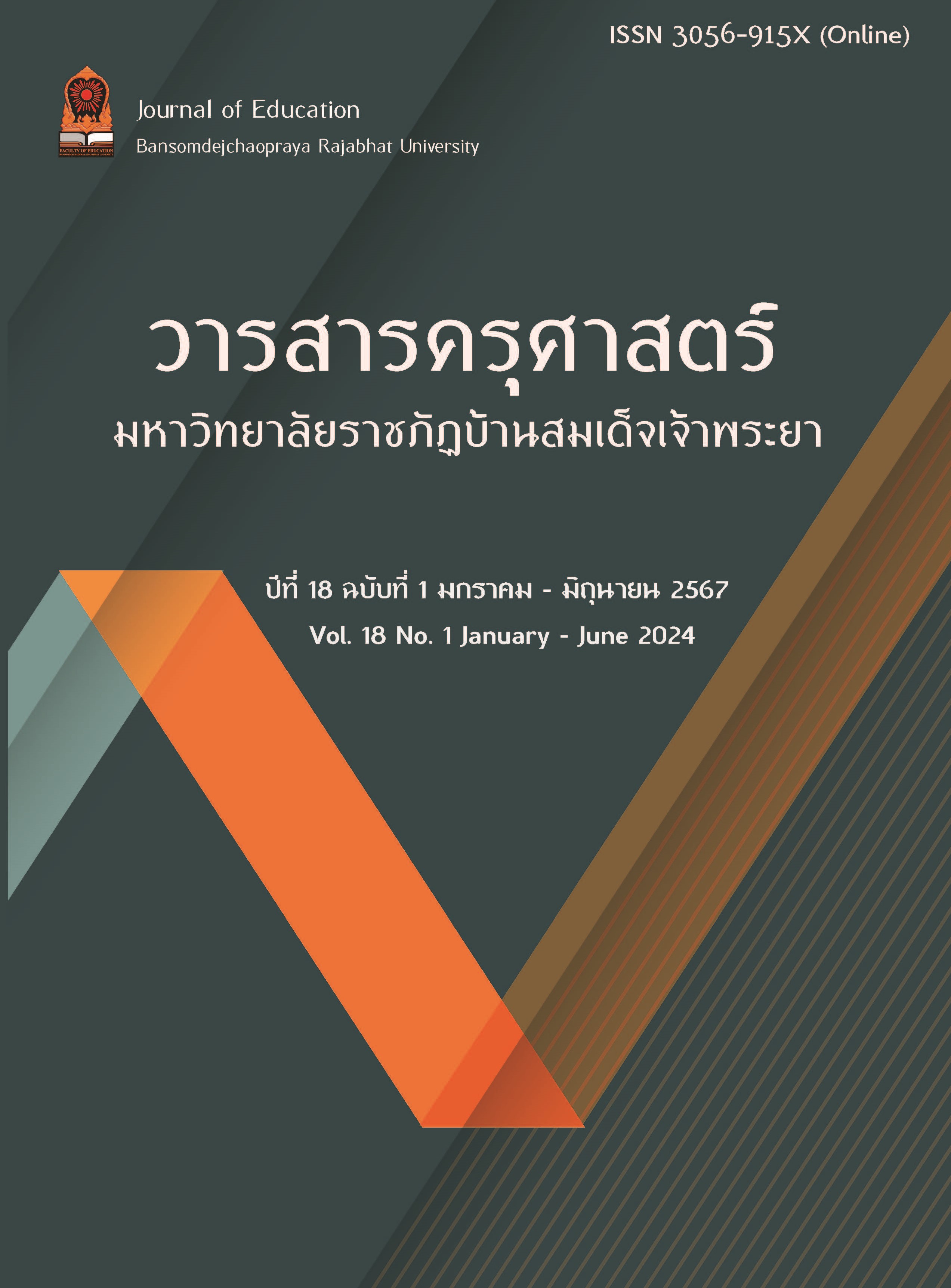The Development of a Mathematics Learning Management Model Based on Constructivist Concepts Combined with the 4MAT System to Promote Critical Thinking Skills for Grade 3 Students in Kwang Jon Subdistrict School Group
Keywords:
A mathematics learning management model, Constructivist, 4MAT System, Critical ThinkingAbstract
The research objectives were 1) to develop a mathematics learning management model based on constructivist concepts combined with the 4MAT system to promote critical thinking skills; 2) to study the results of using a mathematics learning management model based on constructivist concepts combined with the 4MAT system to promote critical thinking skills, and 3) to evaluate and improve a mathematics learning management model based on constructivist concepts combined with the 4MAT system to promote critical thinking skills. The sample group consisted of 27 students in grade 3 at Ban Nong Kung School, Kwang Jon subdistrict school group, in the first semester of the academic year 2022, obtained through cluster random sampling. The research instruments were a mathematics learning management model based on constructivist concepts combined with the 4MAT system to promote critical thinking skills, a critical thinking assessment with a reliability of 0.89, a mathematics achievement test with a reliability of 0.95, and a satisfaction questionnaire on learning with the model with a reliability of 0.93. The statistics used for data analysis were mean, standard deviation, and t-test.
The research findings were as follows:
1) A mathematics learning management model based on constructivist concepts combined with the 4MAT system to promote critical thinking skills was found to have a high level of appropriateness. (= 4.44, S.D. = 0.58).
2) The use of a mathematics learning management model based on constructivist concepts combined with the 4MAT system to promote critical thinking skills resulted in higher post-study critical thinking skills and learning achievement than pre-study at a statistical significance level of.05. The students had the highest level of satisfaction with a mathematics learning management model based on constructivist concepts combined with the 4MAT system to promote critical thinking skills. ( = 4.32, S.D.=0.46).
3) Experts certified a mathematics learning management model based on constructivist concepts combined with the 4MAT system to promote critical thinking skills, finding that it had an average Index of Item-Objective Congruence (IOC) of 0.82, indicating that it was appropriate and could be used.
Downloads
References
กระทรวงศึกษาธิการ. (2552). หลักสูตรแกนกลางการศึกษาขั้นพื้นฐาน พุทธศักราช 2551. กรุงเทพฯ: คุรุสภาลาดพร้าว.
กัญญา ศรีสุข. (2558). การพัฒนาชุดการสร้างความรู้ตามแนวทฤษฎีคอนสตรัคติวิสต์ เรื่อง การสะกดคำในภาษาไทย สำหรับนักเรียนชั้นประถมศึกษาปี่ที่ 4. วารสารการบริหารการศึกษา. (5)2, 152-159.
ญาสุมน พรหมพิทยาจารย์, (2556). ผลการสอนโดยใช้รูปแบบการเรียนรู้แบบโฟร์แมทที่มีต่อผลสัมฤทธิ์ทางการเรียนคณิตศาสตร์ของนักเรียนชั้นประถมศึกษาปีที่ 2. วารสารวิชาการเครือข่ายบัณฑิตศึกษามหาวิทยาลัยราชภัฏภาคเหนือ. (3)5, 55-66.
นิตยา ฉิมวงศ์. (2551). การเปรียบเทียบความสามารถในการคิดอย่างมีวิจารณญาณและผลสัมฤทธิ์ทางการเรียนกลุ่มสาระการเรียนรู้คณิตศาสตร์ เรื่อง ความน่าจะเป็นของนักเรียนชั้นมัธยมศึกษาปีที่ 3 ที่ได้รับการสอนโดยรูปแบบการเรียนรู้ตามทฤษฎีคอนสตรัคติวิสต์และการสอนตามปกติ. (วิทยานิพนธ์การศึกษามหาบัณฑิต,มหาวิทยาลัยมหาสารคาม.
บุญชม ศรีสะอาด. (2550). วิธีการทางสถิติสำหรับการวิจัยเล่ม 1. กรุงเทพฯ: สุวิริยาสาส์น.
พชรภรณ์ เชียงสิน, (2561). การพัฒนารูปแบบการจัดการเรียนรู้ที่เสริมสร้างการคิดอย่างมีวิจารณญาณทางคณิตศาสตร์ของชั้นมัธยมศึกษาปีที่ 2. วารสารวิชาการ Veridian E-Journal. (11)1,698.
เพ็ญประภา อุดมฤทธิ์. (2558). การศึกษาผลสัมฤทธิ์ทางการเรียนคณิตศาสตร์ โดยใช้ชุดการเรียนการสอน เรื่องสมการกําลังสอง ของนักเรียนชั้นมัธยมศึกษาปีที่ 3 ตามแนวคิดคอนสตรัคติวิสต์ร่วมกับวิธีการเรียนแบบร่วมมือเทคนิค STAD. (วิทยานิพนธ์ศึกษาศาสตรมหาบัณฑิต, มหาวิทยาลัยรามคำแหง).
สำนักงานเขตพื้นที่การศึกษาประถมศึกษาชัยภูมิ เขต 2. (2564). รายงานผลการดำเนินงาน ประจำปีงบประมาณพ.ศ. 2564. กลุ่มนโยบายและแผน.
สุมาลี ชัยเจริญ และคณะ. (2559). เทคโนโลยีการศึกษา : หลักการ ทฤษฎี สู่การปฏิบัติ. (พิมพ์ครั้งที่ 2) ขอนแก่น: คลังนานาวิทยา.
อมรรัตน์ มุสิกะโรจน์. (2557). ผลการใช้กิจกรรมการเรียนรู้ แบบ 4MAT ที่มีต่อความสามารถในการคิดวิเคราะห์และผลสัมฤทธิ์ทางการเรียนวิชาภาษาไทยของนักเรียนชั้นมัธยมศึกษาปีที่4 โรงเรียนตะเครียะวิทยาคม จังหวัดสงขลา. (วิทยานิพนธ์ศึกษาศาสตรมหาบัณฑิต, มหาวิทยาลัยสุโขทัยธรรมาธิราช).
Bandman, E.L. & Bandman, B. (1995). Critical Thinking: Tools for Taking Charge of Your Professional and Personal Life. Connecticut: Appleton & Lange
Fosnot, C.T. (1996). Constructivism: Theory, Perspectives, and Practice. New York: Teacher College Press
McCarthy, Bernice. (1990). 4 Mat in Action. New York: West Station Street.
Downloads
Published
How to Cite
Issue
Section
License
Copyright (c) 2024 Faculty of Educaion Bansomdejchaopraya Rajabhat University

This work is licensed under a Creative Commons Attribution-NonCommercial-NoDerivatives 4.0 International License.
บทความที่ได้รับการตีพิมพ์เป็นลิขสิทธิ์ของคณะครุศาสตร์ มหาวิทยาลัยราชภัฏบ้านสมเด็จเจ้าพระยา
ข้อความที่ปรากฏในบทความแต่ละเรื่องในวารสารวิชาการเล่มนี้เป็นความคิดเห็นส่วนตัวของผู้เขียนแต่ละท่านไม่เกี่ยวข้องกับมหาวิทยาลัยราชภัฏบ้านสมเด็จเจ้าพระยา และคณาจารย์ท่านอื่นๆในมหาวิทยาลัยฯ แต่อย่างใด ความรับผิดชอบองค์ประกอบทั้งหมดของบทความแต่ละเรื่องเป็นของผู้เขียนแต่ละท่าน หากมีความผิดพลาดใดๆ ผู้เขียนแต่ละท่านจะรับผิดชอบบทความของตนเอง



